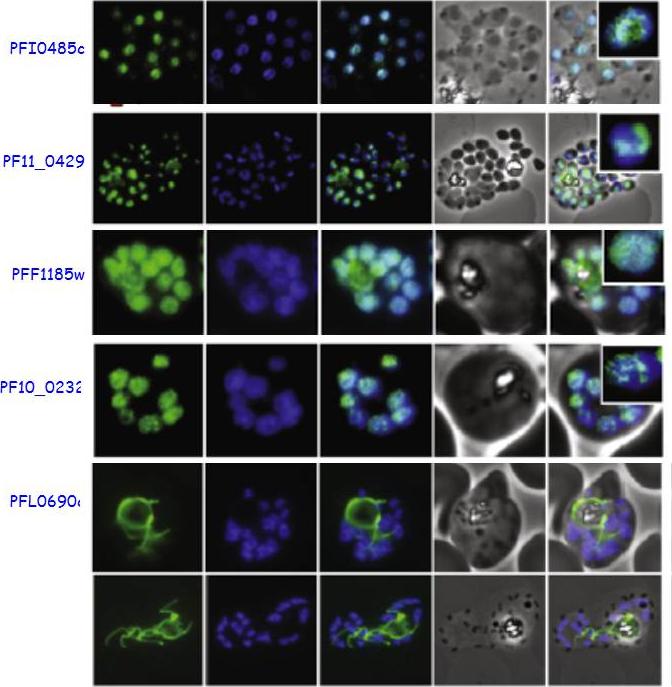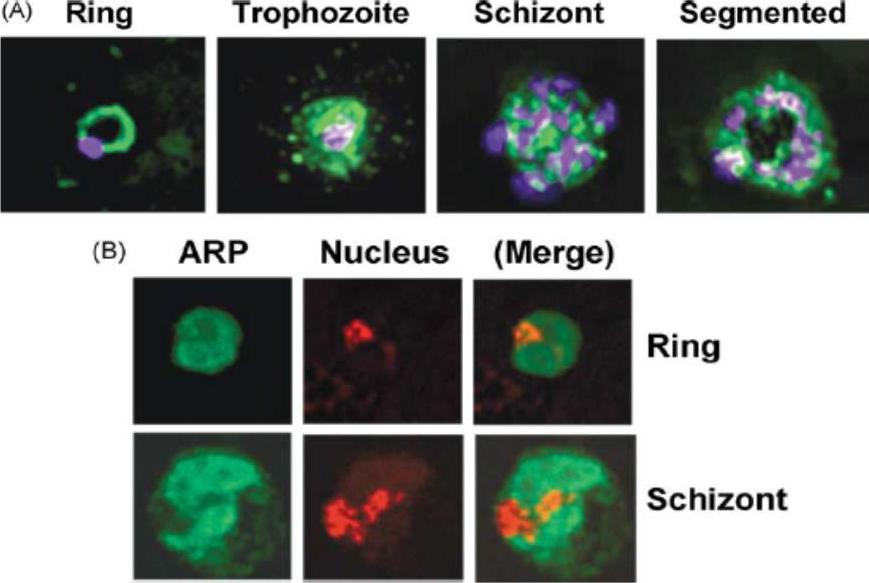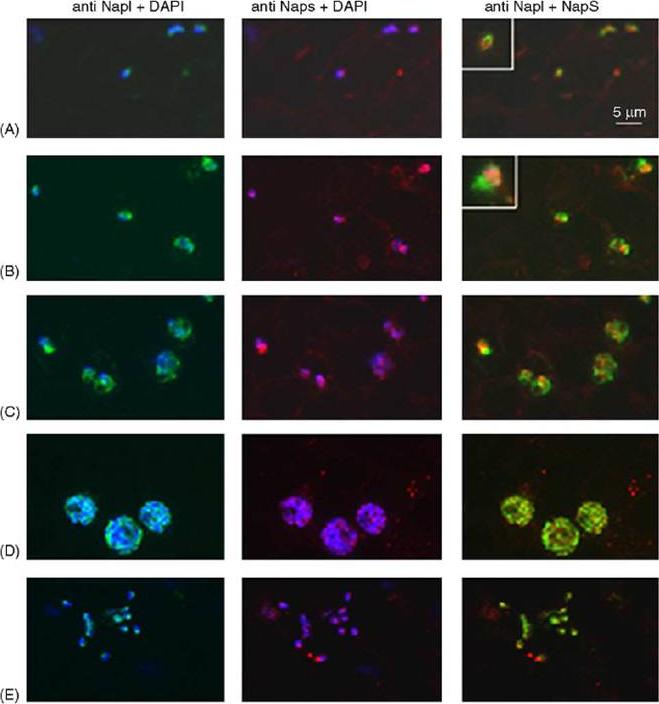PF3D7_0919000 nucleosome assembly protein (NAPS)
Disruptability [+]
| Species | Disruptability | Reference | Submitter | |
|---|---|---|---|---|
| P. falciparum 3D7 |
Possible |
USF piggyBac screen (Insert. mut.) | USF PiggyBac Screen | |
| P. berghei ANKA |
Refractory |
RMgm-246 | Imported from RMgmDB | |
Mutant phenotypes [+]
None reported yet. Please press the '+' button above to add one.Imaging data (from Malaria Metabolic Pathways)

Live imaging of GFP-transgenic Plasmodium falciparum lines reveals the localization of 4 nuclear proteins, which localize to the central part of the nucleus stained by DAPI (blue panel) and the bottom one which localizes to the mitochondrion. Insets show one enlarged schizont nucleus.Volz J, Carvalho TG, Ralph SA, Gilson P, Thompson J, Tonkin CJ, Langer C, Crabb BS, Cowman AF. Potential epigenetic regulatory proteins localise to distinct nuclear sub-compartments in Plasmodium falciparum. Int J Parasitol. 2010 40(1):109-21. Copyright Elsevier
See original on MMP
Nucleosome assembly protein PFI0930c localizes to the far nuclear periphery. (A,B) PFI0930c is either tagged with GFP or Cherry, respectively. Co-localization studies by immunofluorescence reveal its localization to the nuclear periphery, which is marked by CenPA (histone H3)and delimited by the nuclear envelope marker Nup100 (A), but not to the cytoplasmic portion of the cell marked by aldolase (PF14_0425) and ERD2 (PF13_0280) (B). Co-localisation of PFI0930c-cherry and aldolase, used as a cytoplasmic marker showed clear separation of nuclear and cytoplasmic regions in the P. falciparum cell. Co-localisation analysis with Nup100 and ERD2, a marker for the cis- and trans-Golgi showed the same overlapping localisation of PFI0930c-cherry and Nup100, both in an internal location relative to ERD2.Volz J, Carvalho TG, Ralph SA, Gilson P, Thompson J, Tonkin CJ, Langer C, Crabb BS, Cowman AF. Potential epigenetic regulatory proteins localise to distinct nuclear sub-compartments in Plasmodium falciparum. Int J Parasitol. 2010 40:109-21. Copyright Elsevier 2010.
See original on MMP
Immunofluorescence microscopy was done as described under Section 2. (A) Thin smears were incubated with rabbit anti-ARP antibody. The secondary antibody was Cy2-conjugated (green), and nuclei were stained with DAPI (purple by computer color rendition). Fluorescence was viewed in a Nikon TE200 microscope equipped with DeltaVision software for deconvolution and reconstruction of 3D volume as described [23]. As and where described, the ring, trophozoite, schizont, and segmented stages of the parasite were probed. (B) The secondary antibody was FITC-conjugated (green), and nuclei were stained with TO-PRO-3 iodide (red). A ring and a schizont are shown as representative examples. The protein was located mainly in the parasitic cytoplasm. Thus, PfARP is a unique cytoplasmic member of the SET/TAF-family and a candidate physiological regulator of the Plasmodium PP2A.Dobson S, Kumar R, Bracchi-Ricard V, Freeman S, Al-Murrani SW, Johnson C, Damuni Z, Chakrabarti D, Barik S. Characterization of a unique aspartate-rich protein of the SET/TAF-family in the human malaria parasite, Plasmodium falciparum, which inhibits protein phosphatase 2A. Mol Biochem Parasitol. 2003 126:239-50. Copyright Elsevier 2009.
See original on MMP
Stage specific expression of PfNapS-GFP chimeras Localization of PfNapS. The first column shows DIC (Differential Interference Contrast) images, followed by images with a nuclear DAPI stain, GFP fluorescence, an overlay of the nuclear and the GFP localization and overlay of all four images. The protein chimeras showed a nuclear localization in all stages of erythrocytic life-cycle as determined by co-localization with the nuclear stain DAPI,Gill J, Kumar A, Yogavel M, Belrhali H, Jain SK, Rug M, Brown M, Maier AG, Sharma A. Structure, localization and histone binding properties of nuclear-associated nucleosome assembly protein from Plasmodium falciparum. Malar J. 2010 9:90.
See original on MMP
Double immunofluorescence analysis of PfNAPL and PfNAPS in asexual and sexual parasites. Acetone fixed parasites were reacted with rabbit anti-NAPL antibodies and a rat anti-NAPS antibody (1:400). Anti-PfNAPL fluorescence (green, first column) and anti-PfNAPS fluorescence (red, second column) were obtained reacting the samples with fluorescein-conjugated anti rabbit IgG antiserum and rhodamine-conjugated anti rat IgG antiserum (1:200) (Cappel), and are combined with DAPI fluorescent signal. Composite picture of PfNAPL and PfNAPS fluorescent signals is shown in the “merge” column, in which DAPI fluorescence is not shown for clarity. Panel A: early rings; B: late rings; C: trophozoites/early schizonts; D: schizonts; E: free merozoites; Inserts at the right end in panels A and B contain higher magnification of an individual parasite at that time point. Bar is 5mm. PfNAPS did not co-localise with PfNAPL and was more intimately associated with the parasite nucleus,Chandra BR, Olivieri A, Silvestrini F, Alano P, Sharma A. Biochemical characterization of the two nucleosome assembly proteins from Plasmodium falciparum. Mol Biochem Parasitol. 2005 142:237-47. Copyright Elsevier 2009.
See original on MMPMore information
| PlasmoDB | PF3D7_0919000 |
| GeneDB | PF3D7_0919000 |
| Malaria Metabolic Pathways | Localisation images Pathways mapped to |
| Previous ID(s) | PFI0930c |
| Orthologs | PBANKA_0819900 , PCHAS_0820200 , PKNH_0717000 , PVP01_0717400 , PVX_099365 , PY17X_0823200 |
| Google Scholar | Search for all mentions of this gene |